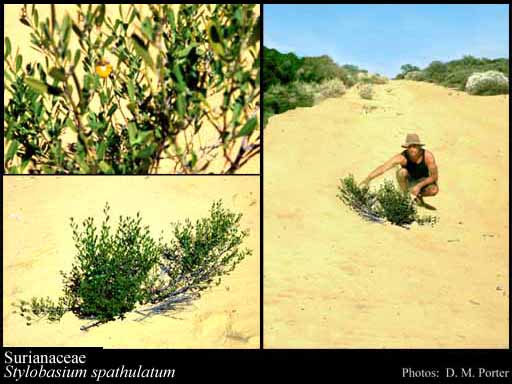- Reference
- Prodr.Fl.Ind.Orient. 360 (1834)
- Name Status
- Current

Scientific Description
Common name. Suriana Family.
Habit and leaf form. Shrubs. Xerophytic (coastal). Leaves small to medium-sized; alternate; spiral; ‘herbaceous’, or leathery; petiolate; non-sheathing; simple. Leaf blades entire; acicular, or oblanceolate; one-veined, or pinnately veined; cross-venulate; attenuate at the base. Leaves without stipules. Leaf blade margins entire. Stem anatomy. Secondary thickening developing from a conventional cambial ring.
Reproductive type, pollination. Fertile flowers hermaphrodite. Unisexual flowers absent. Plants hermaphrodite.
Inflorescence and flower features. Flowers aggregated in ‘inflorescences’; in cymes. The terminal inflorescence unit cymose. Inflorescences axillary; few flowered cymes. Flowers bracteate (the bracts large); bracteolate; small; regular; 5 merous; cyclic; pentacyclic. Free hypanthium present (inconspicuous), or absent. Hypogynous disk absent. Perianth with distinct calyx and corolla; 10; 2 -whorled; isomerous. Calyx 5; 1 -whorled; gamosepalous (below, the lobes acuminate); imbricate; regular; persistent. Corolla 5; 1 -whorled; polypetalous; imbricate; regular. Petals shortly clawed. Androecium 10. Androecial members free of the perianth; markedly unequal (the inner shorter); free of one another; 2 -whorled. Androecium exclusively of fertile stamens, or including staminodes (the inner members often sterile or abortive). Staminodes when present, 5; non-petaloid. Stamens 5, or 10; isomerous with the perianth, or diplostemonous; oppositisepalous (the inner whorl oppositipetalous); both opposite and alternating with the corolla members. Anthers dorsifixed; versatile; dehiscing via longitudinal slits; introrse. Gynoecium 5 carpelled. Carpels isomerous with the perianth. Gynoecium apocarpous; eu-apocarpous; superior. Carpel stylate; with a gynobasic style; 2 ovuled. Placentation (sub-) basal. Ovules funicled; ascending; collateral; non-arillate; anatropous.
Fruit and seed features. Fruit fleshy; an aggregate (of 3–5 carpels). The fruiting carpel indehiscent; drupaceous. Seeds non-endospermic. Cotyledons 2 (usually thickened). Embryo curved (hippocrepiform).
Geography, cytology, number of species. World distribution: coasts of Atlantic tropical America, tropical East Africa, Madagascar, Mascarenes, Indian Ocean Islands, Ceylon to Malay Peninsula, Eastern Malaysia, Northeast Australia, Formosa, Philippines. 1 species.
Keys
Western Australian Genera and Families of Flowering Plants — an interactive key
T.D. Macfarlane, L. Watson, N.G. Marchant